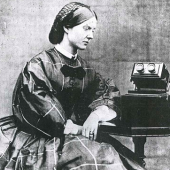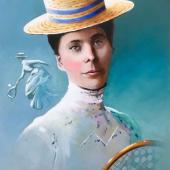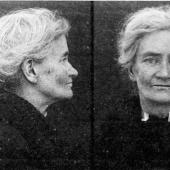The 8th of March marks International Women’s Day, a global celebration of the achievements of women. This year we are marking the occasion with a list of 10 Extraordinary Irish Women. Though this list is by no means exhaustive, it serves as a highlight reel showcasing some of the stand-out women of Irish blood and birth from history.

#1 Kitty Wilkinson
Born in Derry in 1786, Kitty Wilkinson migrated with her family to Liverpool at a young age. On her journey across the Irish sea her ship got into difficulty and her father and sister were both drowned. She settled in Liverpool where she is remembered today as ‘The Saint of the Slums’. She earned this moniker when she opened up her home as a wash house during a catastrophic cholera outbreak in the 1830’s. She also cared for and educated the orphaned children of her community in the years following the epidemic. She was personally gifted a silver teapot by Queen Victoria for her years of selfless service.
READ MORE: Short Biography of Kitty Wilkinson
#2 Margaret Haughery
Born in Leitrim in 1813, Margaret Haughery arrived in the States at the age of 5. In 1835 she married her husband Charles and the pair relocated to New Orleans. Sadly Charles did not live much longer. Widowed and alone in a new city, Margaret threw herself into her volunteer work. She became involved with Orphanage, eventually leaving her job to dedicate herself full time to the orphans. She worked tirelessly to provide aid for the Orphanage, carefully investing her funds in profitable business ventures. Her philanthropic work earned her the name, ‘The Angel of the Delta’ and her memory has been kept alive by the erection of a monument in her honour.
READ MORE: Short Biography of Margaret Haughery
#3 Mary Ward
Born in 1827 in Offaly, Mary Ward is deeply connected with Birr Castle as she was a first cousin of the owner and spent a great deal of time there. As a child, Mary had a keen interest in drawing insects and plants which she placed under a microscope. As an adult she self published a book of these drawings. Her work with both microscopes and telescopes was very well respected. She had two publications on display at the 1862. Crystal Palace exhibition. She was also one of the very few women to be added to the mailing list of the English Royal Astronomical Society. Mary is also remembered in history for her death as she was the first person in Ireland to die in an automobile accident.
READ MORE: Short Biography of Mary Ward
#4 Eliza Lynch
Eliza Lynch was born in 1833 in Cork. She left Ireland at the age of 10 when her family relocated to France to escape the Famine. Six years later she married a French officer and followed him to Algiers where she spent two years before having her marriage annulled. She became an important member of French society, befriending Napoleon’s niece. She then entered into life as a courtesan. This was how she met the son of the President of Paraguay. The two struck up a passionate romance. Eliza went to Paraguay with this man and though they never married, when he succeeded his father she became the de facto First Lady of Paraguay. During a bitter war with Brazil and Uruguay, Eliza’s partner and eldest son were both killed. She took her remaining five children and fled back to France where she spent the rest of her days.
READ MORE: Short Biography of Eliza Lynch
#5 Lena Rice
Lena Rice was born in 1866 in Tipperary. From a young age Lena exhibited a great skill and passion for the game of tennis. By her early 20’s, Lena was gaining a great deal of attention as she collected title after title. In 1889 she became the first Irish woman to reach the finals of Wimbledon, though she would not win the women’s singles title until the following year. In that year, 1890, an Irish person also won the men’s singles at Wimbledon, a great year for Irish sport. Lena’s legacy lies not only in her trailblazing trophy wins, but also in the use of her signature move, the overhead smash which she is credited with inventing.
READ MORE: Short Biography of Lena Rice
#6 Sister Nivedita
Born Margaret Elizabeth Noble in Tyrone in 1867, Sister Nivedita would go on to have a huge impact in her adopted home of India. A qualified teacher, she made great strides in improving the education system in England. As a young woman she discovered the teachings of eastern religions, specifically Buddhism and Hinduism. This is the path that led her to relocate to India where she dedicated herself to the education of girls in poorer communities. She established a school in Calcutta which she funded herself with her book sales. During the 1899 epidemic of plague in India, Sister Nivedita worked tirelessly to provide aid to the sick. She also raised awareness of the epidemic back in England by writing to a number of news publications. She is remembered today by an inscription on her grave memorial which reads,
“Here reposes Sister Nivedita who gave her all to India”
READ MORE: Short Biography of Sister Nivedita
#7 Kathleen Lynn
Born in Mayo in 1874, Kathleen Lynn enjoyed a privileged upbringing. However, she was aware of the suffering and poverty of the people of rural Ireland. Called to a career in medicine, Kathleen trained in Dublin, Manchester, and Dusseldorf. She then returned to Ireland where she became a fellow of the Royal College of Surgeons. However, she was met with resistance in her career as many of her male colleagues refused to work with her. She eventually established her own practice in Rathmines. During the Dublin Lock Out, Doctor Lynn became involved in the cause for Irish independence. She was appointed Chief Medical Officer of the Irish Citizens Army for the 1916 Easter Rising, and it was her involvement in this that saw her temporarily imprisoned. Doctor Lynn never married but lived with her long-term companion Madeleine Ffrench-Mullen, and her diary entries suggest that the two enjoyed a romantic relationship.
READ MORE: Short Biography of Kathleen Lynn
#8 Violet Gibson
Violet Gibson was born in Dublin in 1876. Violet lived a difficult life. Health problems troubled her for many years. Her generally poor health was exacerbated by a botched appendicitis which left her with lifelong abdominal pain. In 1922 she suffered from a nervous breakdown and was subsequently committed to an asylum. After her release, she relocated to Rome where she lived in a convent. There Violet became convinced that God wanted her to kill someone. On the 7th of April 1926, she put this belief into action. She famously shot the fascist leader of Italy, Mussolini as he moved through a crowd. The shot hit his nose as he moved his head just in time to dodge a fatal blow. On her second attempt, the gun misfired. Violet was deported to England for her attempt on Mussolini’s life, and she spent the rest of her days in an asylum. Though she is undoubtedly a controversial figure, there is now a campaign for Violet to be commemorated with a plaque in her native Dublin.
READ MORE: Short Biography of Violet Gibson
#9 Hanna Sheehy-Skeffington
Hanna Sheehy was born in Cork in 1877. She trained as a teacher and lived in Dublin where she counted James Joyce amongst her friends. It was he that introduced Hanna to her husband Francis Skeffington. The two became a true power couple. They broke with tradition by amalgamating their surnames and getting married in their graduation robes as opposed to a suit and dress. Hanna was highly involved in political activity, especially the cause for Irish independence. During the Easter Rising, Francis was killed under highly controversial circumstances. The loss of her husband did not deter her from her politics. Hanna was a key figure in the battle for women’s suffrage and famously smashed a window at Dublin Castle after the right for women to vote was left out of the Home Rule Bill. A plaque now commemorated the place where this happened.
READ MORE: Short Biography of Hanna Sheehy - Skeffington
Learn More The Road to Sufferage
#10 Sophie Peirce-Evans
Born in Limerick in 1896, Sophie Peirce-Evans, also known as Mary Heath, was Ireland’s own Amelia Earhart. A talented sportswoman from a young age, Sophie excelled in a number of athletic pursuits, but it was her interest in aviation that secured her position in the history books. Through her lobbying work, Sophie eventually became the first woman in Britain or Ireland to fly planes commercially after the governing bodies had banned women from doing so. In 1929 she famously carried out the first solo flight from Cape Town to London. The harrowing journey took five months and launched Sophie to international fame. That same year her aviation career came to a sudden end when she suffered terrible injuries in a crash. A scale model of Sophie’s plane is housed in the Little Museum of Dublin.
READ MORE: Short Biography of Sophie Peirce - Evans
Mná na hÉireann
The stories of these extraordinary women showcase the various impacts that Irish women throughout history have had an impact on social reform, education, sport, and healthcare. There are many many more stories of fascinating women on the IrelandXO Chronicles which we invite you to investigate.
Read More
- Pioneering Irish Women of Sport
- Pioneering Irish Women of STEM
- Australian Women of Irish Descent
- A Beginner's Guide to Irish Surnames
- Irish Naming & Baptism Traditions
Make sure to add the Extraordinary Irish Women from your family tree to the IrelandXO Chronicles.
We hope you have found the information we have shared helpful. While you are here, we have a small favour to ask. Ireland Reaching Out is a non-profit organisation that relies on public funding and donations to ensure a completely free family history advisory service to anyone of Irish heritage who needs help connecting with their Irish place of origin. If you would like to support our mission, please click on the donate button and make a contribution. Any amount, big or small, is appreciated and makes a difference.










